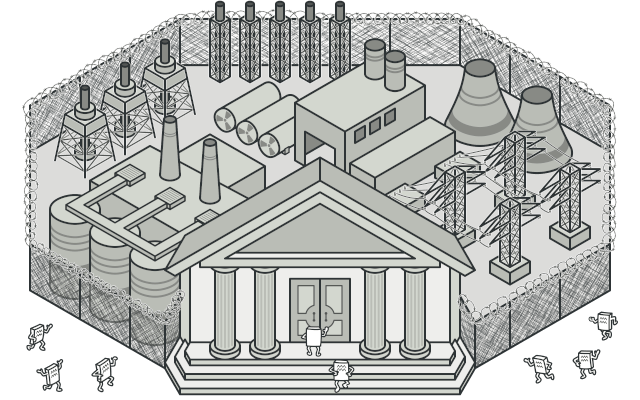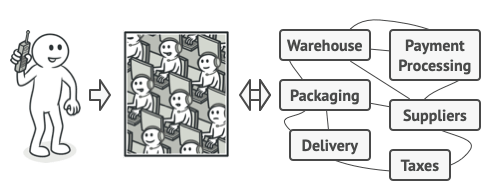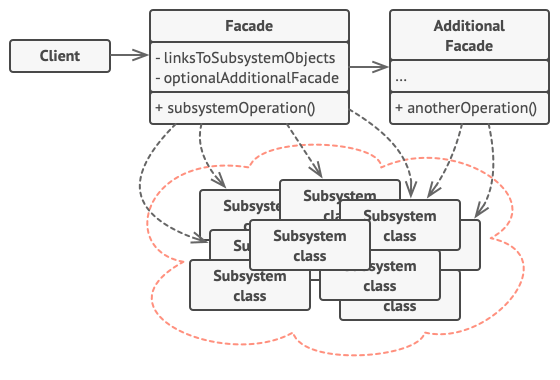Facade design Pattern
Facade is a structural design pattern that provides a simplified interface to a library, a framework, or any other complex set of classes.

Problem
Imagine that you must make your code work with a broad set of objects that belong to a sophisticated library or framework. Ordinarily, you’d need to initialize all of those objects, keep track of dependencies, execute methods in the correct order, and so on.
As a result, the business logic of your classes would become tightly coupled to the implementation details of 3rd-party classes, making it hard to comprehend and maintain.
Solution
A facade is a class that provides a simple interface to a complex subsystem which contains lots of moving parts. A facade might provide limited functionality in comparison to working with the subsystem directly. However, it includes only those features that clients really care about.
Having a facade is handy when you need to integrate your app with a sophisticated library that has dozens of features, but you just need a tiny bit of its functionality.
For instance, an app that uploads short funny videos with cats to social media could potentially use a professional video conversion library. However, all that it really needs is a class with the single method encode(filename, format). After creating such a class and connecting it with the video conversion library, you’ll have your first facade.
Real-World Analogy

Placing orders by phone.
When you call a shop to place a phone order, an operator is your facade to all services and departments of the shop. The operator provides you with a simple voice interface to the ordering system, payment gateways, and various delivery services.
Structure

The Facade provides convenient access to a particular part of the subsystem’s functionality. It knows where to direct the client’s request and how to operate all the moving parts.
An Additional Facade class can be created to prevent polluting a single facade with unrelated features that might make it yet another complex structure. Additional facades can be used by both clients and other facades.
The Complex Subsystem consists of dozens of various objects. To make them all do something meaningful, you have to dive deep into the subsystem’s implementation details, such as initializing objects in the correct order and supplying them with data in the proper format.
Subsystem classes aren’t aware of the facade’s existence. They operate within the system and work with each other directly.
The Client uses the facade instead of calling the subsystem objects directly.
Pseudocode
In this example, the Facade pattern simplifies interaction with a complex video conversion framework.

An example of isolating multiple dependencies within a single facade class.
Instead of making your code work with dozens of the framework classes directly, you create a facade class which encapsulates that functionality and hides it from the rest of the code. This structure also helps you to minimize the effort of upgrading to future versions of the framework or replacing it with another one. The only thing you’d need to change in your app would be the implementation of the facade’s methods.
// These are some of the classes of a complex 3rd-party video
// conversion framework. We don't control that code, therefore
// can't simplify it.
class VideoFile
class OggCompressionC
class MPEG4CompressionCodec
class CodecFactory
class BitrateReader
class AudioMixer
// We create a facade class to hide the framework's complexity
// behind a simple interface. It's a trade-off between
// functionality and simplicity.
class VideoConverter is
method convert(filename, format):File is
file = new VideoFile(filename)
sourceCodec = (new CodecFactory).extract(file)
if (format == "mp4")
destinationCodec = new MPEG4CompressionCodec()
else
destinationCodec = new OggCompressionCodec()
buffer = BitrateReader.read(filename, sourceCodec)
result = BitrateReader.convert(buffer, destinationCodec)
result = (new AudioMixer()).fix(result)
return new File(result)
// Application classes don't depend on a billion classes
// provided by the complex framework. Also, if you decide to
// switch frameworks, you only need to rewrite the facade class.
class Application is
method main() is
convertor = new VideoConverter()
mp4 = convertor.convert("funny-cats-video.ogg", "mp4")
mp4.save()

Comments
Post a Comment